Description
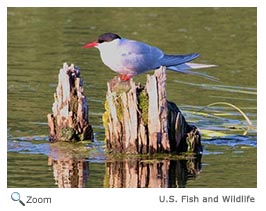 The Arctic tern is 14-17 inches in length and has a wingspan of 26-32 inches. It has a white throat, neck, and breast, soft gray upperparts and wings, and a black cap on its head. It has a long, pointed, forked tail and pointed wings edged with a dark line. It has very short legs, and it looks like it is crouching down when it stands. During breeding season, its bill, legs, and feet are a bright orange-red. Males and females look alike. The Arctic tern is 14-17 inches in length and has a wingspan of 26-32 inches. It has a white throat, neck, and breast, soft gray upperparts and wings, and a black cap on its head. It has a long, pointed, forked tail and pointed wings edged with a dark line. It has very short legs, and it looks like it is crouching down when it stands. During breeding season, its bill, legs, and feet are a bright orange-red. Males and females look alike.
Range 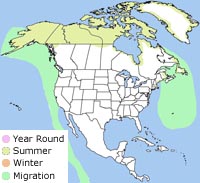 The Arctic tern is circumpolar. That means it is found around the polar regions. In North America, it breeds
across Alaska and northern Canada, south to northern British Columbia , the Hudson Bay, and along the Atlantic Coast to Massachusetts. It winters on the ice pack off of Antarctica. It is also found in Greenland, Iceland, and northern Europe and Asia. The Arctic tern is circumpolar. That means it is found around the polar regions. In North America, it breeds
across Alaska and northern Canada, south to northern British Columbia , the Hudson Bay, and along the Atlantic Coast to Massachusetts. It winters on the ice pack off of Antarctica. It is also found in Greenland, Iceland, and northern Europe and Asia.
Habitat
The Arctic tern breeds on
open tundra, in boreal forests, or on rocky islands and beaches. It winters on the ice pack off of Antarctica.
Diet
The Arctic tern flies 30-40 feet over the water and then dives into the water to catch small fish and crustaceans. It also eats insects. | |
Life Cycle
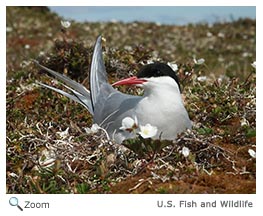 The Arctic tern mates when it is 3-4 years old. The male courts the female by chasing her in the air and then offering her a fish. The male selects a breeding territory and aggressively protects it. The Arctic tern nests in colonies. The Arctic tern mates when it is 3-4 years old. The male courts the female by chasing her in the air and then offering her a fish. The male selects a breeding territory and aggressively protects it. The Arctic tern nests in colonies.
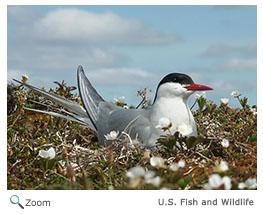 The female lays 1-3 eggs in a scrape on the ground that is lined with grass, gravel, or shells. The eggs are a speckled gray and white and blend in with the ground. Both the male and the female incubate the eggs for 21-22 days. Both parents bring the chicks small fish until the chicks fledge at 21-28 days old. Male and female pairs mate for more than one year and may mate for life. The female has one brood a year. Arctic terns can live to be 34 years old. The female lays 1-3 eggs in a scrape on the ground that is lined with grass, gravel, or shells. The eggs are a speckled gray and white and blend in with the ground. Both the male and the female incubate the eggs for 21-22 days. Both parents bring the chicks small fish until the chicks fledge at 21-28 days old. Male and female pairs mate for more than one year and may mate for life. The female has one brood a year. Arctic terns can live to be 34 years old.
Behavior
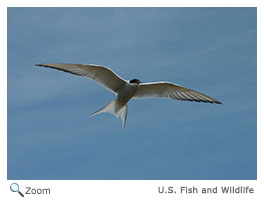 The Arctic tern travels from pole to pole and back again every year. They don't fly in a straight line. they fly in a zig-zag pattern and may fly as many as 44,000 miles to each pole and back! Each fall, the Arctic tern heads east, flying across the Atlantic Ocean. It continues south down the coasts of Europe and Africa, flying until it reaches the Antarctic Ocean. In the spring, it flies north up the coasts of South and North America until it reaches the Arctic Ocean. The Arctic tern travels from pole to pole and back again every year. They don't fly in a straight line. they fly in a zig-zag pattern and may fly as many as 44,000 miles to each pole and back! Each fall, the Arctic tern heads east, flying across the Atlantic Ocean. It continues south down the coasts of Europe and Africa, flying until it reaches the Antarctic Ocean. In the spring, it flies north up the coasts of South and North America until it reaches the Arctic Ocean.
It hardly ever rests on its trip. It is almost constantly in flight or diving to the ocean for food. Each part of the tern's trip takes about 90 days. It may spend more time in daylight than any other animal! It leaves the Arctic as the days start to get shorter in the Northern Hemisphere and travels to Antarctica as the days are getting longer in the Southern Hemisphere.
|



 The Arctic tern is circumpolar. That means it is found around the polar regions. In North America, it breeds
across Alaska and northern Canada, south to northern British Columbia , the Hudson Bay, and along the Atlantic Coast to Massachusetts. It winters on the ice pack off of Antarctica. It is also found in Greenland, Iceland, and northern Europe and Asia.
The Arctic tern is circumpolar. That means it is found around the polar regions. In North America, it breeds
across Alaska and northern Canada, south to northern British Columbia , the Hudson Bay, and along the Atlantic Coast to Massachusetts. It winters on the ice pack off of Antarctica. It is also found in Greenland, Iceland, and northern Europe and Asia.


